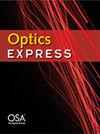利用集成光子存储计算和未经训练的 K 近邻算法识别弹性光网络中的调制格式
IF 3.2
2区 物理与天体物理
Q2 OPTICS
引用次数: 0
摘要
在下一代弹性光网络中,各种调制格式在传输过程中对信道损伤表现出不同程度的敏感性。为了在接收器上采用适当的信道均衡方案,必须在接收器之前进行调制格式识别,然后根据识别结果调整接收器参数和类型。本文提出了一种基于 52 节点集成光子存储芯片和未经训练的 K 近邻(KNN)算法的系统,用于识别光信道传输中的 OOK、PAM4、QPSK 和 BPSK 调制格式。考虑到 20 千米单模光纤传输的色散破坏,在 8 至 23 dB 的光信噪比范围内对其性能进行了验证。在所有测试场景中,识别准确率始终超过 96.25%,与之前的研究相比提高了 14.93%,与相同条件下的传统算法相比提高了 82.81%。研究探讨了不同波导延迟量、随机相位和算法 K 值对识别准确率的影响。本文章由计算机程序翻译,如有差异,请以英文原文为准。
Modulation format identification in elastic optical networks using integrated photonic reservoir computing and untrained K-nearest neighbors algorithm
In the next generation of Elastic Optical Networks, various modulation formats exhibit varying degrees of sensitivity to channel impairments during transmission. To adopt appropriate channel equalization schemes at the receiver, it is essential to perform modulation format identification prior to the receiver, followed by the adjustment of receiver parameters and types based on the recognition results. A system based on a 52-node integrated photonic reservoir chip and untrained K-nearest neighbors (KNN) algorithm is proposed for the recognition of OOK, PAM4, QPSK, and BPSK modulation formats in optical channel transmission. Its performance is validated across optical signal-to-noise ratios ranging from 8 to 23 dB, taking into account the dispersion damage of 20 km single-mode fiber transmission. In all tested scenarios, the recognition accuracy consistently surpasses 96.25%, showcasing a 14.93% improvement over prior works and an 82.81% enhancement over traditional algorithmic methods under identical conditions. The study explores the impact of different waveguide delay amounts, random phases, and algorithm K values on recognition accuracy.
求助全文
通过发布文献求助,成功后即可免费获取论文全文。
去求助
来源期刊

Optics express
物理-光学
CiteScore
6.60
自引率
15.80%
发文量
5182
审稿时长
2.1 months
期刊介绍:
Optics Express is the all-electronic, open access journal for optics providing rapid publication for peer-reviewed articles that emphasize scientific and technology innovations in all aspects of optics and photonics.
 求助内容:
求助内容: 应助结果提醒方式:
应助结果提醒方式:


